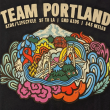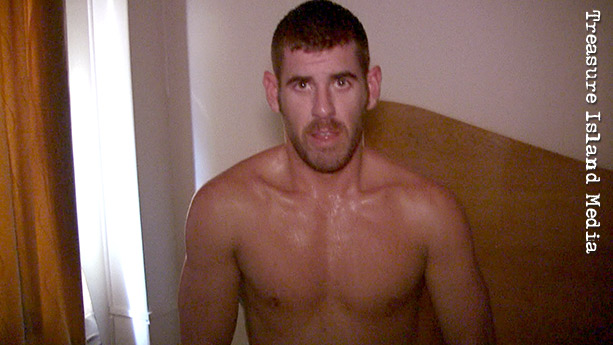A standing-room-only crowd packed the house at Magnet on December 3 for a lively Real Talk discussion about condomless sex and HIV prevention.
Moderated by Naked Sword director mr. Pam and featuring a panel of community members and experts, the forum considered questions such as: Why do gay and bisexual men have condom-free sex? Are community attitudes around condom use changing? How do treatment as prevention and pre-exposure prophylaxis (PrEP) factor into the equation?
Coming from a community that strongly espoused condom use, mr. Pam said she was always harping on the men she works with to use them, but acknowledged that “it’s like telling high school students to practice abstinence—it’s not going to happen.”
In an anonymous audience text poll, 100% of attendees said they had ever fucked without a condom, 80% said the rules around condomless sex are changing in San Francisco, and only 37% thought condom use is now the norm. Most reported that they’d had sex with someone of a different HIV status, or didn’t know whether they had.
Dr. Joanna Eveland of Mission Neighborhood Health Center started out with some definitions and trends in HIV and sexually transmitted infections (STIs) in San Francisco.
Today, “safer sex” goes beyond just condom use and may include strategies such as serosorting (having sex only with people of the same HIV status), choosing sex acts and top or bottom positions based on status (“seropositioning”), and using antiretroviral drugs as prevention. Surveys by the Stop AIDS Project found that in 2008 about 40% of HIV-negative men and half of HIV-positive men reported using any “seroadaptive” strategy.
Based on his experience as an HIV test counselor and community organizer at Magnet, Jared Hemming thinks men are using a broad range of tools. “The rules are definitely changing and people are using different strategies,” he said.
“The problem with a condoms-only approach to safe sex is that I certainly want condomless sex,” said Chrissy Scardina of Stop AIDS, who is HIV negative and on PrEP. But he added that “getting new technologies and strategies doesn’t mean letting go of old strategies that are working, it means diversify.”
Gonorrhea, chlamydia, and syphilis rates rose between 2008 and 2012, according to figures from San Francisco City Clinic, suggesting that more people are having unprotected sex. But the rate of new HIV infections has declined or remained stable overall. This may indicate that more men are using safer sex strategies that protect against HIV but not other STIs. There was small uptick in HIV incidence between 2010 and 2011, but it’s too soon to tell whether this is the start of an upward trend.
“San Francisco is ahead of the game” when it comes to HIV testing and treatment, Dr. Eveland said. While the Centers for Disease Control and Prevention (CDC) estimates that 20% of people with HIV nationwide do not know they’re infected, that drops to around 7% in San Francisco.
During early infection—before the body makes enough antibodies to show up on a standard screening test—HIV viral load is often very high, posing the greatest risk of transmission. But suppressing viral load with antiretroviral therapy dramatically lowers the risk. A large study of serodiscordant heterosexual couples in Africa (HTPN 052) showed that when the positive partner was treated, the risk of transmission fell by 96%. If a large proportion of people are on treatment, “community viral load” goes down, as well.
San Francisco was the first city to recommend that everyone who tests positive should consider treatment—regardless of their CD4 T-cell count—both for their own health and to reduce the risk of transmission. While only 25% of people with HIV nationwide have been tested, entered care, and achieved viral suppression, according to the CDC, in San Francisco the proportion is closer to half.
Safer Sex Strategies
Asked about what safer sex strategies they use or recommend, panel members discussed a range of options.
“We have come a long way since ‘Play Fair‘ and ‘How to Have Sex in an Epidemic‘ and we have more tools in our toolkit,” said Alan Guttirez of Lyric, who is HIV-negative, referring to two pioneering safer sex resources.
“Condom use has been a pendulum,” suggested Daniel Ramos, a pharmacy specialist with the AIDS Healthcare Foundation who is HIV-positive and until recently was in a long-term serodiscordant relationship. When HIV came on the scene there was a big push to get people to use condoms, but “people got exhausted being force-fed the message to use them.”
“Talk to your partners prior to sex, know what to look for, what things should and should not smell like,” he advised. “But you can’t really judge a book by its cover, so discussion is important—but not easy.”
Scardina recommended getting tested for STIs every three to six months. Having other STIs increases the risk of both transmitting and acquiring HIV. If you have something, tell your partners. “It’s not a pleasant conversation, but it’s the right conversation for our community,” he said. (Magnet and the SF Department of Public Health offer anonymous services that will contact partners and tell them they’ve been exposed to STIs; the inSPOT website serves a similar function.)
Regular HIV testing is also important. A recent CDC study showed that the longer gay men went between tests, the more likely they were to be infected without knowing it. “When asking a partner’s status, the follow-up should be ‘When were you last tested?’” Dr. Eveland said.
What about PrEP?
One of the newest tools in the prevention toolbox, PrEP, got a lot of attention at the forum. An audience poll showed that 23% had either used PrEP or had a partner who had done so.
Hemming reviewed some data from major PrEP studies. The iPrEx study of men who have sex with men found that daily PrEP using Truvada (Gilead Science’s tenofovir/emtricitabine combination pill) lowered HIV infection risk by more than 90% among participants who had blood drug levels indicating that they took it regularly.
Dr. Eveland stressed that Truvada “is not a morning-after pill” and must be taken every day. Studies are underway looking at intermittent PrEP taken before and after sex, but so far research only supports daily use with good adherence.
Scardina related that he first heard about PrEP after doing post-exposure prophylaxis, or PEP—taking antiretrovirals after exposure to prevent HIV from establishing infection. He then enrolled in City Clinic’s PrEP study, which provided him with a year’s worth of Truvada.
“Truvada has worked really well for me,” he said. “I haven’t relied solely on PrEP and still use condoms depending on the situation.”
Speaking from the audience, activist attorney David Waggoner said he started taking Truvada PrEP four years ago, long before it was approved by the FDA. He too had taken PEP multiple times after unprotected sex and asked his doctor if he could just stay on antiretrovirals for prevention.
As for why PrEP has not “caught on like wildfire,” Hemming noted that it can be a challenge to take pills every day. In a majority of PrEP studies, many or most people did not take it as directed. Some people are also fearful about PrEP after seeing the debilitating side effects of older antiretroviral drugs. “People are scared of what it’s going to do to their body,” he said.
Truvada is generally well tolerated but can cause kidney problems and bone loss in some people. According to Dr. Eveland, the most common side effects are fatigue and gastrointestinal symptoms. But Scardina said he has had “barely any side effects,” while Waggoner reported that he “never had any side effects at all.”
The cost of Truvada—about $1,000 per month—is also a barrier. Guttirez brought up the issue of low-income people and people of color who may not have access to PrEP. Scardina just turned 26 and has to go off his parents’ health plan. “I’m running out of pills and I don’t have insurance,” he lamented.
Even for people who are insured, Truvada for prevention may be hard to come by. Waggoner related that a friend seeking PrEP from Kaiser Permanente was required to go before a panel of doctors to be grilled about his sexual behavior and level of risk. Another audience member, however, said he was able to get Truvada PrEP through Kaiser with little difficulty. Waggoner also noted that Gilead offers a patient assistance program for people who cannot afford Truvada PrEP.
Slut-Shaming
Several panelists and audience members brought up the issue of “slut-shaming,” or moralistic objections to people who use PrEP or other risk-reduction strategies instead of using a condom every time they have sex.
“Science is still lower on the hierarchy than morality,” said Waggoner. “Puritanical ideas are guiding social policy.”
Guttirez and others raised the issue of discrimination on the basis of positive or negative status being replaced by discrimination based on viral load or PrEP use. “Where is the space for men with detectable viral load,” he asked?
“As a positive person, I feel if said ‘I love to take loads and give them’ I’ll be stigmatized…People will say ‘Typhoid Mary is running around,’” Ramos declared. “I have to be more responsible [for HIV prevention] than a negative person…The onus on the positive person has been unfair for awhile, and it’s good to see negative men now taking responsibility.”
“Not having the trauma of losing all your friends has impacted the way [younger guys] have sex and the harm reduction strategies we employ,” Guttirez acknowledged. “Shaming from elders with the intention of wanting to support comes off as a scare tactic that I don’t think is successful.”
“There’s a lot of room for queer and trans people to grow together talking about HIV intergenerationally,” he said. “We don’t have to leave these conversations in the bedroom.”
Note: This article does not necessarily represent the opinions of Paul Morris or Treasure Island Media. We felt it right to post, allowing each of you to digest, and form your own opinion. We look forward to hearing what you think.













